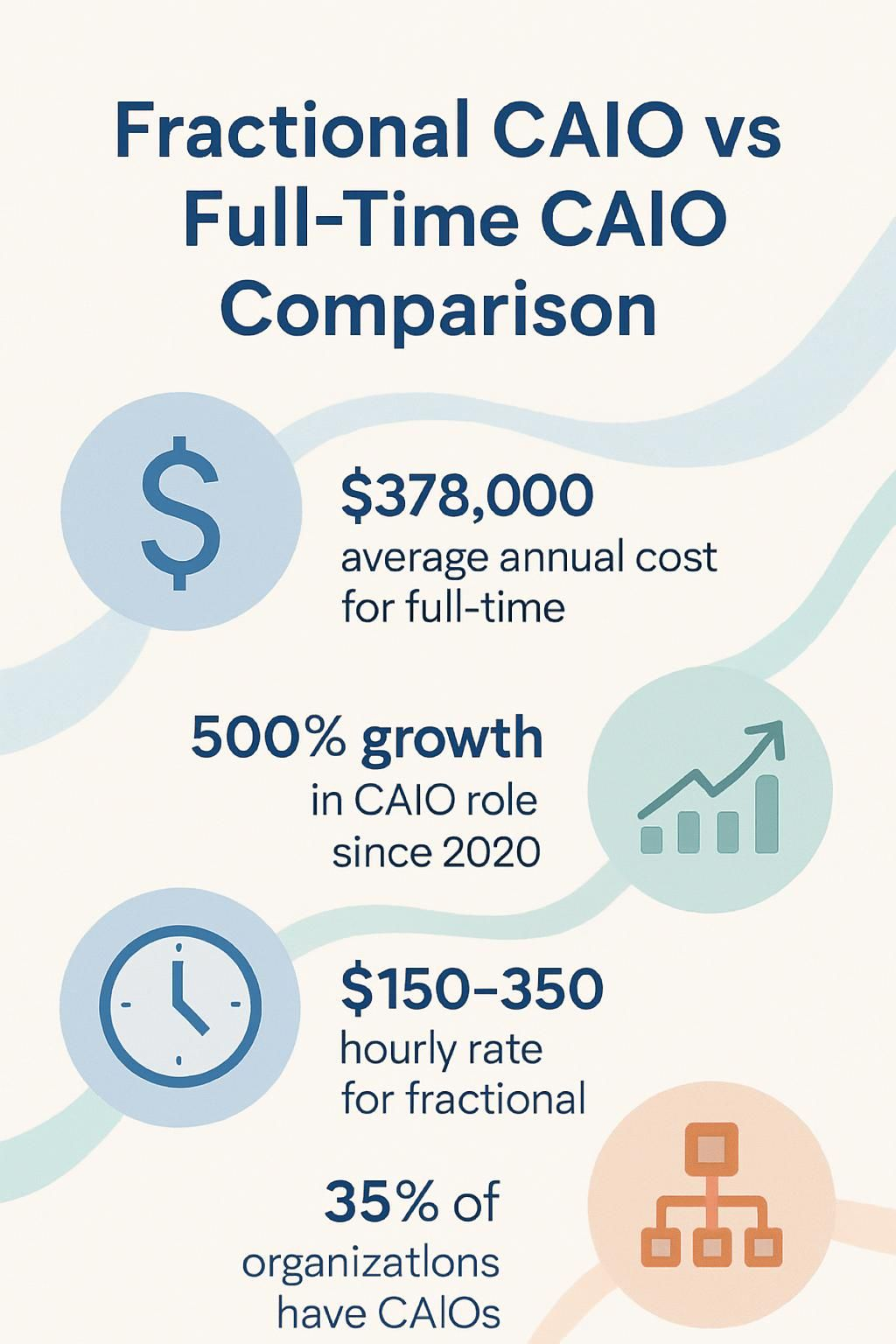Fractional CAIO vs Full-Time CAIO Comparison


Understanding AI Integration

The Chief AI Officer (CAIO) role has exploded in popularity, with Gartner reporting that 35% of organizations now have this position or something similar. Five years ago, this job barely existed.
Companies face a critical choice: hire a full-time AI executive at roughly $378,000 per year or bring on a fractional CAIO who works part-time across multiple organizations. This decision impacts how businesses implement artificial intelligence strategies and manage their technology budgets.
Fractional CAIOs offer specialized expertise without the hefty price tag of a full-time executive. They typically charge hourly rates or monthly retainers, making AI leadership accessible to smaller companies and startups.
For example, a fractional executive working 20 hours weekly at $300 per hour saves about $130,000 annually compared to a $250,000 full-time hire.
Full-time CAIOs shine in large enterprises with complex, ongoing AI needs. They develop comprehensive strategies and integrate deeply with leadership teams. Meanwhile, fractional leaders bring cross-industry knowledge and flexible engagement models without long-term contracts.
As founder of WorkflowGuide.com, I have observed how the right AI leadership transforms businesses. My experience building over 750 workflows and generating $200M for partners taught me that successful AI integration requires strategic thinking, not just fancy tools.
The CAIO role, whether fractional or full-time, bridges this gap by connecting technical capabilities with business goals.
Your budget, project scope, and organizational needs should drive your choice between these options. Let's break down the key differences to help you decide which model fits your company best.
Key Takeaways
- Fractional CAIOs cost significantly less than full-time ones, with full-time positions averaging $378,000 annually plus benefits.
- Small businesses gain access to high-level AI expertise through fractional leadership without committing to long-term executive salaries.
- Full-time CAIOs integrate deeply into company culture and attend all executive meetings, building stronger cross-departmental relationships.
- The CAIO role has grown by 500% since 2020, with Gartner reporting 35% of organizations now having this position.
- Fractional CAIOs typically offer flexible engagement models including hourly rates ($150-350), project-based fees ($5,000-25,000), or monthly retainers ($3,000-8,000).

Understanding the Role of a Chief AI Officer (CAIO)

A Chief AI Officer serves as the strategic leader for a company's artificial intelligence initiatives. This role has grown rapidly, with Gartner reporting 35% of organizations now having a CAIO position, compared to almost none five years ago.
The CAIO acts as the AI strategist, making decisions that transform how your business handles customer interactions, financial forecasting, and supply chain operations. They don't just implement advanced technology; they align AI initiatives with your business goals while addressing ethical concerns and regulatory requirements.
The CAIO emerged as a direct response to the AI advancements reshaping business functions across industries. With tools like ChatGPT making significant impacts, companies need someone who can distinguish between AI potential and genuine business value.
Your CAIO becomes the connection between technical possibilities and practical applications, ensuring your AI investments deliver tangible results rather than just spending resources on trendy technologies.
Having this leadership role also demonstrates to stakeholders that your company prioritizes responsible AI practices. Now we'll explore how a Fractional CAIO might offer a flexible solution for businesses not yet prepared for a full-time commitment.
Want To Be In The Inner AI Circle?
We deliver great actionable content in bite sized chunks to your email. No Flim Flam just great content.

Fractional CAIO: A Flexible Solution
Fractional CAIOs offer a smart hack for businesses that need AI leadership without the full-time price tag. Think of them as your AI strategy superheroes who swoop in when needed, solve complex problems with cross-industry knowledge, and then don't hang around billing you while you implement their solutions.
Cost-effectiveness for smaller businesses
Small businesses face a challenging financial decision when considering AI leadership. A full-time Chief AI Officer costs around $378,000 annually according to Glassdoor, plus benefits and overhead costs.
That's a significant portion of budget for companies with limited resources. Fractional CAIOs offer an effective solution. They provide high-level AI expertise at a reduced cost, similar to how a fractional COO working 20 hours weekly at $300/hour costs about $130,000 less compared to a $250,000 full-time hire.
AI expertise shouldn't be limited to companies with large budgets. Fractional leadership makes access to transformative talent more widely available.
The cost efficiency goes beyond salary savings. Non-tech founders gain access to strategic AI guidance without the long-term commitment or infrastructure requirements of a full-time executive.
This part-time leadership model gives smaller companies a similar competitive advantage as larger corporations, including valuable vendor networks and cross-industry insights. The cost-effective approach allows businesses to allocate resources to other essential areas while still implementing advanced AI strategies suited to their specific needs.
Access to diverse, cross-industry expertise
Fractional CAIOs bring a treasure chest of knowledge from multiple industries to your business table. They've seen AI succeed (and fail) across different sectors, giving them a sixth sense for spotting opportunities others might miss.
Your local plumbing business could benefit from AI tactics that worked wonders in healthcare or retail. This cross-pollination of ideas often leads to breakthrough solutions that single-industry experts simply can't imagine.
One client told me they got more actionable AI ideas in two hours with their fractional CAIO than in six months with their tech team.
The part-time nature of fractional leadership creates a fascinating side effect: these professionals constantly absorb fresh perspectives as they bounce between companies. They function like AI strategy bees, collecting innovative pollen from various business flowers and bringing it directly to you.
This arrangement lets small and mid-sized businesses tap into the same caliber of AI thinking that powers Fortune 500 companies, without the crushing salary commitment. The flexibility of this model makes it perfect for companies who need specialized guidance but aren't ready for a full-time executive salary on their books.
Now let's explore the typical engagement models and pricing structures you might encounter when hiring a fractional CAIO.
Engagement Models and Pricing
- Hourly consultation packages range from $150-350 per hour depending on the CAIO's experience level and industry expertise.
- Project-based engagements typically cost $5,000-25,000 for specific initiatives like AI strategy development or implementation roadmaps.
- Monthly retainer models provide regular access to your fractional CAIO for 10-20 hours per month, usually priced between $3,000-8,000.
- Quarterly strategy sessions offer periodic check-ins and course corrections without the commitment of monthly services.
- Assessment packages include AI readiness evaluations and opportunity analyses as standalone offerings or entry points to longer engagements.
- Success-based fee structures tie part of the compensation to measurable business outcomes like cost reduction or revenue growth.
- Hybrid models combine fixed retainers with performance bonuses for exceeding agreed-upon KPIs.
- On-demand emergency support provides quick access during critical situations at premium hourly rates.
- Knowledge transfer packages focus on training your internal team while building your AI capabilities.
- Phased implementation plans break larger AI initiatives into manageable chunks with clear deliverables and payment milestones.
- Trial engagements let you test the waters with a small-scope project before committing to longer-term relationships.
- Service level agreements clearly define response times, deliverable expectations, and communication cadence for all engagement types.
Full-Time CAIO: A Long-Term Commitment
Full-Time CAIOs bring dedicated AI leadership to your organization, embedding deeply into your company culture and driving long-term vision with consistent daily oversight. A full-timer sits in every executive meeting, shapes AI strategy from the ground up, and builds relationships across departments that part-time executives simply can't match.
Think of them as the difference between owning a car versus renting one—you'll pay more upfront, but the keys are always in your pocket. Ready to explore whether this investment makes sense for your business goals?
Comprehensive AI strategy development
Full AI strategy development forms the backbone of any successful artificial intelligence initiative. A dedicated Chief AI Officer builds roadmaps that connect your business goals with AI capabilities.
They don't just pick cool tech tools (I've seen too many businesses fall into that shiny-object trap). Instead, they analyze your data infrastructure, identify automation opportunities, and create systems that grow with your company.
Think of it like building a custom gaming PC rather than buying a pre-built one. You need someone who understands both the parts and how they work together for your specific needs.
This approach requires deep integration with existing business processes. Your CAIO partners with data management platforms like Whoop and Snowflake to maximize AI applications. They coordinate with your CIO and CTO to prevent role overlap while pushing innovation forward.
Recent advancements in business analytics and agentic AI capabilities get properly vetted and implemented where they make sense. I've watched companies waste thousands on AI tools that collect digital dust because they skipped this critical planning phase.
A proper strategy doesn't just adopt technology; it transforms how your business operates.
Seamless integration into leadership teams
Full-time CAIOs slide into executive teams like that last puzzle piece you've been hunting for. They attend weekly meetings, join strategy sessions, and build strong bonds with other C-suite members.
This integration matters hugely for AI success. Daniel Cho points out that while CIOs handle infrastructure and security, CAIOs focus on creating business value through AI applications.
A permanent CAIO builds trust over lunch chats and hallway conversations that simply can't happen with part-time arrangements.
The magic happens when your CAIO forms a tight partnership with other executives, especially the CIO. Think of it as Batman and Robin, but for your data strategy. They share knowledge, align goals, and tackle problems together daily.
Your CAIO needs time to understand company politics, build alliances, and navigate the organization's unwritten rules. This deep integration creates stability and consistent leadership that drives AI initiatives forward, turning your company from AI-curious to AI-powered without the start-stop rhythm that often plagues fractional arrangements.
Key Factors to Consider When Choosing
Choosing between a fractional or full-time CAIO depends on your company's AI maturity, budget constraints, and strategic goals—factors we'll explore next to help you make the right call for your organization's AI journey.
Budget and resource allocation
Money talks, especially when you're deciding between fractional and full-time CAIOs. Full-time Chief AI Officers cost a pretty penny at around $378,000 per year according to Glassdoor, not counting benefits and overhead costs.
Ouch! For many local businesses, that's a budget-buster. Fractional CAIOs offer a more wallet-friendly option while still giving you access to top AI talent. Smart resource planning means matching your AI needs with the right level of leadership investment. Many tech-savvy business owners find that a part-time CAIO delivers the strategic direction they need without draining their financial reserves.
Your budget constraints will shape this decision more than almost any other factor. The key lies in honest financial assessment of what your company can afford now versus the potential ROI of AI implementation. Project-specific needs often align better with the fractional model, while companies planning massive AI overhauls might benefit from dedicated leadership.
Project-specific versus ongoing needs
Beyond budget concerns, your AI needs often fall into two camps: one-off projects or continuous support. Fractional CAIOs excel at both scenarios without forcing you into a full-time hire.
For startups needing quick wins on specific AI initiatives, a fractional leader can swoop in like a specialized task force, design your roadmap, and launch pilot programs without the long-term commitment. For ongoing AI needs, fractional leaders offer a middle path. They establish governance frameworks and train your team until your AI functions become self-sustaining. Think of them as AI training wheels that eventually come off.
This approach lets you adapt to changing demands while keeping your long-term strategy intact, without locking yourself into a C-suite salary for capabilities you might only need part-time.
Challenges and Considerations
Companies using either leadership model may face specific hurdles. Full-time CAIOs often require longer onboarding periods due to deep integration with internal teams, while fractional CAIOs must balance time efficiently across multiple organizations.
Decisions in Artificial Intelligence Leadership impact Organizational Strategy, AI Governance, and Talent Acquisition. Effective Technology Management and costeffective solutions are critical for Business Innovation and Digital Transformation, regardless of the chosen Leadership Model.
Real-World Outcomes
Several businesses have reported measurable improvements in efficiency and strategic clarity after engaging with either a fractional or full-time CAIO. These outcomes demonstrate that both models provide strong Executive Roles when aligned with sound Organizational Structure and strategic planning.
Clients have experienced benefits in Business Intelligence and Technology Strategy that support robust Consultancy Services while addressing the demands of Digital Transformation and Executive Roles.
Conclusion
Choosing between a fractional CAIO and a full-time CAIO boils down to your specific business needs. Fractional CAIOs offer budget-friendly AI leadership for smaller companies or short-term projects, bringing cross-industry knowledge without the hefty salary commitment.
Full-time CAIOs make sense for large organizations with complex, ongoing AI initiatives that require daily strategic oversight. Your decision should align with your AI maturity, budget constraints, and long-term digital transformation goals.
I've seen companies waste thousands on full-time executives when they only needed quarterly guidance, while others tried to skimp on leadership only to face costly AI failures. The right AI leadership model acts like your tech GPS, guiding your organization through the AI landscape without unnecessary detours.
Ready to make your choice? WorkflowGuide.com can help you assess which CAIO model fits your business reality.
FAQs
1. What is the difference between a fractional CAIO and a full-time CAIO?
A fractional CAIO works part-time for multiple companies, bringing diverse experience at a lower cost. Full-time CAIOs dedicate all their attention to one organization but come with higher salary demands and benefits packages.
2. When should a company hire a fractional CAIO instead of a full-time one?
Startups and mid-sized businesses with budget constraints often benefit most from fractional leadership. They get top AI talent without the financial burden of a permanent executive.
3. What are the cost differences between these two CAIO options?
Fractional CAIOs typically cost 30-60% less than their full-time counterparts. You pay only for the hours you need, avoiding expenses like health insurance, stock options, and other executive perks.
4. Can a fractional CAIO deliver the same results as a full-time CAIO?
Yes. Fractional leaders often bring broader industry knowledge from working across multiple companies. The key trade-off is availability, as they split time between clients, but many organizations find the value and flexibility worth this limitation.
Still Confused
Let's Talk for 30 Minutes
Book a no sales only answers session with a Workflow Guide
References and Citations
Disclosure: This article is informational and not a substitute for professional advice. Some links are affiliate links that help support our work at no extra cost to you.
References
- https://orpical.com/fractional-chief-ai-officers/ (2024-04-12)
- https://cyberfin.net/fractional-caio-unlock-ai-for-insurers-and-boost-growth/
- https://vixure.ai/the-rise-of-the-fractional-caio-navigating-ai-disruption-on-a-budget/
- https://www.a.team/mission/startups-fractional-ai-officers
- https://www.blogs.opengrowth.com/scale-your-ai-strategy-with-a-fractional-caio
- https://jake-jorgovan.com/blog/fractional-executives-vs-full-time
- https://www.techtarget.com/searchenterpriseai/tip/Evaluate-whether-your-organization-needs-a-chief-AI-officer
- https://jake-jorgovan.com/blog/interim-fractional-caio-consultants
- https://www.researchgate.net/publication/380279745_Strategic_Integration_of_Artificial_Intelligence_in_the_C-Suite_The_Role_of_the_Chief_AI_Officer
- https://innovationvista.com/ai/rise-of-caio-vcaio/



